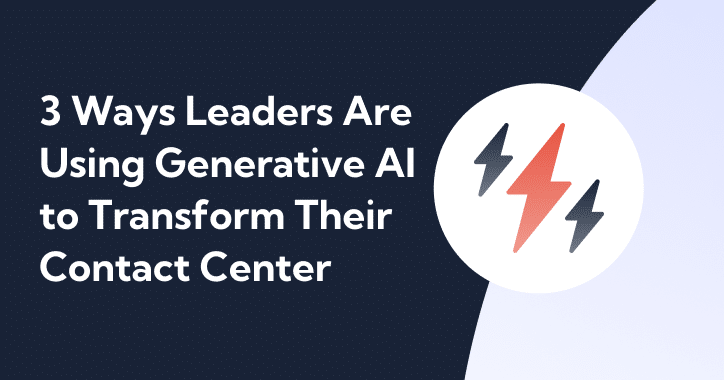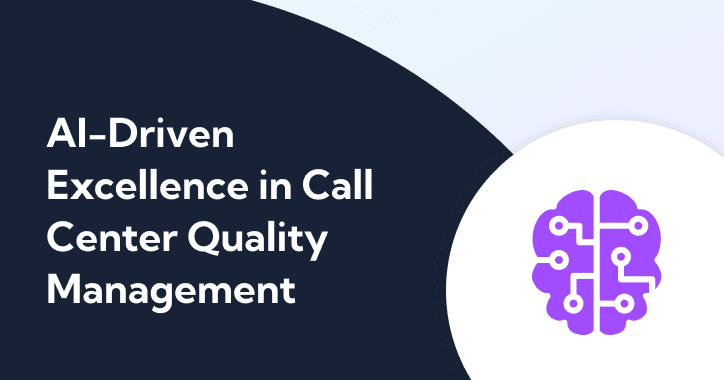The modern contact center strives to be more efficient, more productive, and more profitable than ever, so it’s no surprise that leaders turn to tech to boost performance. But not all solutions are created equal — while collaborative intelligence significantly improves an organization’s efficiency, lazy AI is frustratingly common and far less useful.
Collaborative intelligence learns from the best reps, scales those habits to the entire team, and supports agents through every call with the guidance and insight they actually need to close more sales.
To help you avoid the time and expense of inefficient solutions, we’re continuing to highlight the red flags you should dodge in Part Three of our Lazy AI in the Contact Center series. This time, we’re discussing semantic technology.
Contact centers run on conversation. But human communication is far from binary — it’s nuanced, contextual, and even ambiguous. While agents can usually intuit a customer’s meaning, lazy AI is less skilled in this arena.
Semantic technology assigns meaning to data that would otherwise have none. Just as you can’t respond to someone speaking in a language you don’t know, contact center solutions built on lazy AI lack the semantic capabilities to effectively understand conversations and provide relevant support in response.
So, how can you be sure you’re investing in a solution that speaks your language fluently? Keep an eye out for these pitfalls that may signal lazy AI.
Pursues Automation Over Innovation
Automating repetitive, low-value, and time-consuming tasks is a great way to improve employee productivity and cut waste from the workday. But solutions that offer nothing more than automation are likely hiding their inefficient semantic technology.
For example, QA sampling and scoring is notoriously time consuming, tedious, and results in the application of solutions directed by a small, incomplete data set. Some contact center AI automatically scores calls so managers can focus on other tasks. While this takes an item off of managers’ to-do lists, the scores generally arrive days after calls have ended. Plus, the solution stops short of enhancing operational efficiency.
A better solution might alert managers in real time to an agent’s compliance error and provide customized QA scorecards. Managers could then roll out instant playbook changes based on any trends they notice. But this sort of immediate scoring requires a level of semantic capability that lazy AI simply can’t muster.
As a result, lazy AI focuses on automated features like alerts and keyword-triggered suggestions. It lacks more advanced semantic understanding built through natural language processing (NLP).
collaborative intelligence doesn’t need to dress up automation. Instead, it digs into deeper understanding to provide dynamic, real-time support that’s only possible through things like NLP and machine learning.
If a solution seems keen to automate but unable to innovate, it’s likely a sign of lackluster semantic tech. Automating tasks can help overworked contact center leaders keep their heads above water, but AI must work as an innovative complement to humans, not an automated solution, to unlock new levels of success.
Fixates on ‘Next Time’ with Post-Call Data
The inability to complete a task right away often manifests in the form of future-focus. Being forward-thinking isn’t bad, but every contact center leader knows the most important call is the one happening right now.
Unfortunately, “right now” isn’t how lazy AI functions. Remember that advanced semantic technologies can process language in real time, but underdeveloped tech needs time to catch up.
Because of this, most contact center AI primarily offers post-call insights that can ostensibly be applied to future conversations. But even if an agent knows what they did wrong last time, they may forget to apply changes next time.
Nerves, unexpected objections, and any number of other possibilities can make it tough for agents to remember all the “next time” advice they’ve received, but future-focused advice is the best that lazy AI can do.
For AI to truly stand apart, it has to work in real time, offering immediate support for agents and managers. This shift from focusing on the future to the present enables enterprises to apply solutions in real time, satisfying more customers and delivering better results.
Natural language processing efficient enough to work in real time isn’t built into every solution. Be wary of contact center AI with lots of post-call data but little real-time support.
Relies on Keywords, Ignores Context
There’s nothing wrong with using keywords as a part of semantic technology in contact center AI. In fact, keywords should help shape a solution’s understanding of conversations, but they shouldn’t run the entire operation.
Imagine hearing the sentence “I would love to place an order, it’s just not in the cards right now,” and only understanding the words “place an order.” Your limited understanding would lead you to believe the speaker was, in fact, interested in making a purchase — that’s exactly what happens when solutions rely too heavily on keyword matching.
More robust semantic technology like intent-based voice processing considers the context of the entire conversation to truly understand it. This requires deep learning techniques that lazy AI can’t master.
Enhance Communication with Better Semantic Technology
There’s plenty of contact center AI built on unimpressive semantic tech. But there are also a few systems advanced enough to meaningfully improve operations as a whole.
As you search for the right solution, remember these signs of lazy AI. Don’t forget to check for real-time functionality to ensure the system is advanced enough to support immediate improvements.
As the industry-leading Real-Time Guidance solution, Balto understands the challenges associated with building efficient, collaborative intelligence. We also know that if support doesn’t arrive in real time, then it’s arriving too late, ultimately failing to affect positive change. Real-time is vital for improving contact center operations through better conversations.
For more insight into why real-time is the only real solution for modern contact centers, take a tour of Balto or schedule a demo today.






